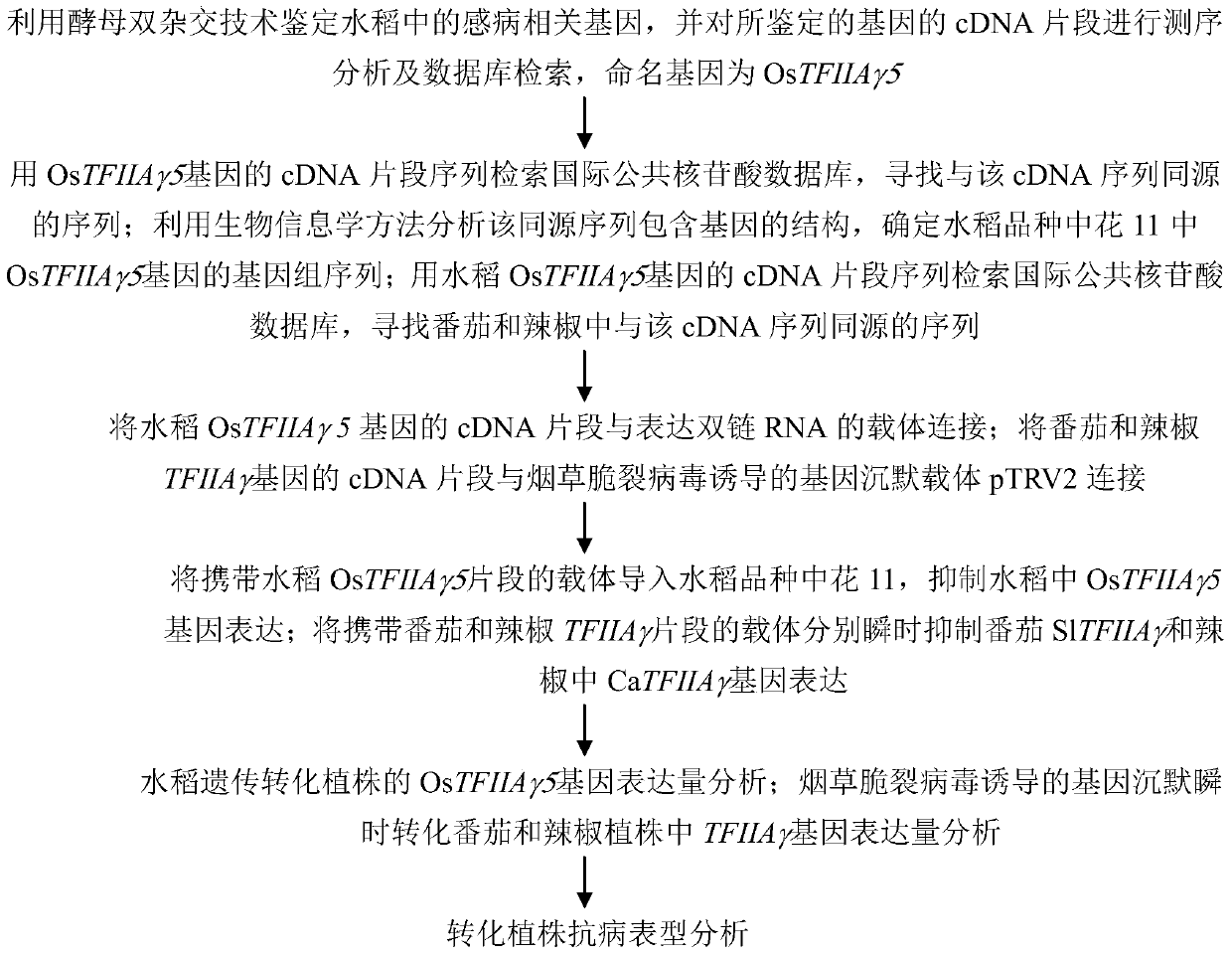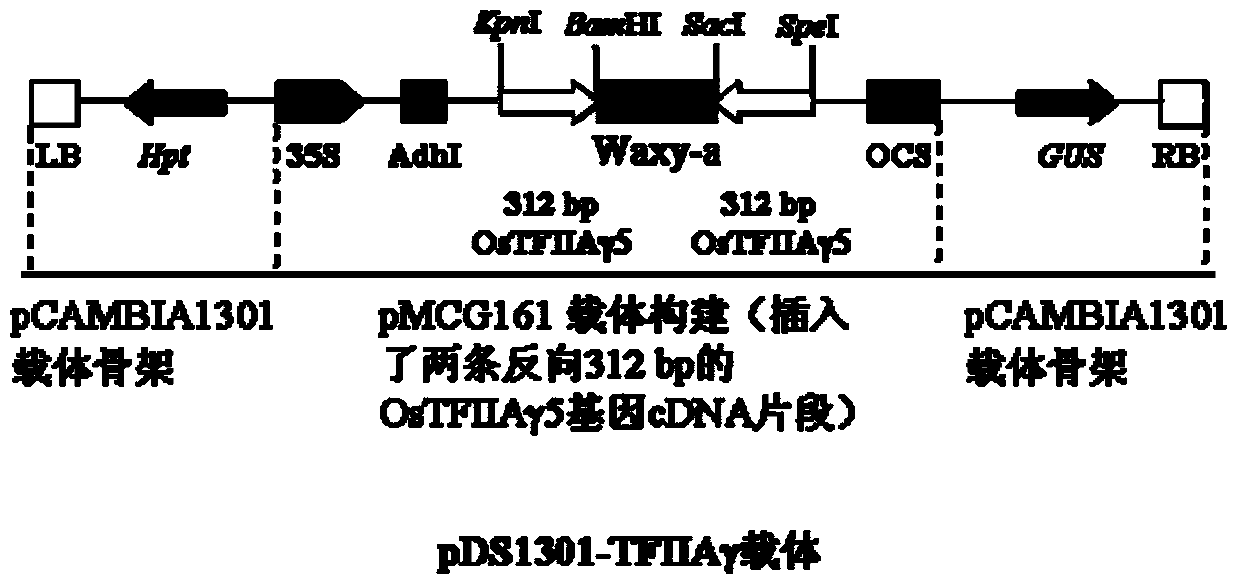Application of suppressing or mutating tfiiaγ gene in crop disease resistance
A gene and gene expression technology, applied in the fields of application, genetic engineering, plant genetic improvement, etc., can solve the problem that the basic transcription factors of the host are not clear about the function
- Summary
- Abstract
- Description
- Claims
- Application Information
AI Technical Summary
Problems solved by technology
Method used
Image
Examples
Embodiment 1
[0034] Example 1: Sequence and structural analysis of the TFIIAγ gene
[0035] 1. Prediction of TFIIAγ gene structure
[0036] The applicant used a DNA sequence (2944bp-3345bp) of a TALE gene pthXo1 (GenBank registration number: ACD58243) of bacterial blight PXO99 as a bait protein to screen the cDNA library of rice variety Zhonghua 11 (Yuan et al., 2010), and screened A cDNA sequence was searched in the nucleotide database GenBank (http: / / www.ncbi.nlm.nih.gov) with the BLAST method (Altschul et al. 1997), and it was found that the cDNA sequence was similar to a gene from the rice variety Nipponbare located on chromosome 5 The sequences above are highly homologous. In the rice genome database TIGR (http: / / rice.plantbiology.msu.edu / ), this rice sequence is annotated as a gene whose number is LOC_Os05g01710, which is the gene OsTFIIAγ5 involved in the present invention.
[0037] 2. Isolation and cloning of OsTFIIAγ5 gene from rice variety Zhonghua 11
[0038] Rice Zhonghua 11...
Embodiment 2
[0049] Example 2: Suppressing the expression of the rice OsTFIIAγ5 gene to verify its function in rice disease resistance
[0050] 1. Construction of expression-suppressing genetic transformation vector
[0051] The present invention uses RNA interference (RNA interference, RNAi) technology (Smith et al., 2000) to verify the function of the gene by inhibiting the expression of the OsTFIIAγ5 gene in rice variety Zhonghua 11. The main mechanism of this technical approach is to connect a partial fragment of the target gene in the form of inverted repeats to a vector capable of expressing double-stranded RNA (double strand RNA, dsRNA), and introduce the vector into plants through genetic transformation. The obtained transformed plants express a large number of dsRNAs homologous to partial fragments of the target gene. These dsRNAs rapidly form short interfering RNA (short interfering RNA, siRNA). These siRNAs are complementary to the transcripts (mRNA) of the target gene, and un...
Embodiment 3
[0073] Example 3: Point mutation of rice OsTFIIAγ5 gene endows it with function in broad-spectrum disease resistance
[0074] 1. Point mutation of rice OsTFIIAγ5 gene endows it with broad-spectrum resistance to bacterial blight
[0075] Rice families IRBB5 and IR24 are near-isogenic lines. IR24 carries the OsTFIIAγ5 gene, and the 39th amino acid of the encoded OsTFIIAγ5 protein is valine (V); IRBB5 carries the mutated OsTFIIAγ5 gene, namely the recessive xa5 gene. The recessive xa5 gene encodes a mutant OsTFIIAγ5 protein (OsTFIIAγ5 V39E or xa5), the 39th amino acid is mutated from valine to glutamic acid (E). At the booting stage, inoculate the Philippine bacterial blight races PXO99, PXO339, PXO61, PXO71, PXO79, PXO86, PXO112, PXO341 and PXO347, the Japanese bacterial blight race T7174, and the Korean bacterial blight races. Species KACC10331, Physiological races of bacterial blight of China Zhe173, FuJ23, KS-1-21 and YN11. The results showed that the resistance of IRBB5 ...
PUM
 Login to View More
Login to View More Abstract
Description
Claims
Application Information
 Login to View More
Login to View More - R&D
- Intellectual Property
- Life Sciences
- Materials
- Tech Scout
- Unparalleled Data Quality
- Higher Quality Content
- 60% Fewer Hallucinations
Browse by: Latest US Patents, China's latest patents, Technical Efficacy Thesaurus, Application Domain, Technology Topic, Popular Technical Reports.
© 2025 PatSnap. All rights reserved.Legal|Privacy policy|Modern Slavery Act Transparency Statement|Sitemap|About US| Contact US: help@patsnap.com



